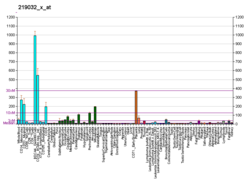Function
Opsins are members of the G protein-coupled receptor superfamily. In addition to the visual opsins, mammals possess several photoreceptive non-visual opsins that are expressed in tissues outside the eye. The opsin-3 gene is strongly expressed in brain and testis and weakly expressed in liver, placenta, heart, lung, skeletal muscle, kidney, and pancreas. The gene is expressed in the skin [8] and may also be expressed in the retina. The protein has the canonical features of a photoreceptive opsin protein, [7] however in human skin, OPN3 is not photoreceptive and acts as a negative regulator of melanogenesis. [9]
This page is based on this
Wikipedia article Text is available under the
CC BY-SA 4.0 license; additional terms may apply.
Images, videos and audio are available under their respective licenses.


